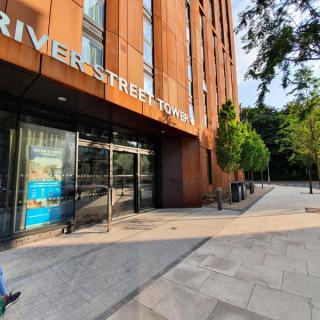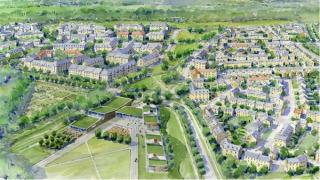
Place
Place is a fundamental component of the national planning and development agenda. It is critical to the creation of sustainable, well-designed places where people want to live, work, learn and play.
The Place team at SLR’s approach is based on a collaboration of disciplines working together to shape and design places in a creative and design-led way. We lead placemaking projects as a way of addressing multiple challenges relating to housing delivery, climate resilience, biodiversity net gain and net-zero to name just a few.

Overview
In a development-led but rapidly changing world, Making Sustainability Happen has moved from being a warm and ethical stance to a human need, which makes practicing our placemaking skills more important than ever.
Get in touchWe work with enthusiasm and invention, solving complex challenges within the places that we work. We think differently, designing for life between, within and beyond buildings and encourage others to do the same. We respond imaginatively to the unique context of every project to improve people’s quality of life, respond to environmental challenges and create value. We carefully analyse landscapes to ensure development is integrated and evaluate its effects.
We strive for beauty and function in all contexts and at every scale. We believe in the power of landscape and architecture within the built and natural environments. Our experience and skills in technical evaluation tell us that the smallest of projects can have a big impact whilst even the largest strategies require a detailed understanding of delivery.
The Place team at SLR work in a landscape-led multi-disciplinary way with extensive and unique experience in the consideration of landscape sensitivities at all scales and all stages. This ensures the natural environment is fully integrated with the built environment.
The team has worked on projects where landscape and nature are the fundamental building blocks, whether delivered through large-scale masterplans, public realm or architecture. We take pride in this and can truly claim that our work is landscape-led.
The Place team has a proven track record of masterplans and designs that integrate natural systems to create a truly combined natural and built environment with multiple recognised benefits, such as the creation of habitats for wildlife, management of surface water to ensure climate resilience, and provision of outdoor play and learning opportunities to connect people and nature. We seek to deliver these benefits within a range of environments, from city centre and urban sites through to new settlements. All our disciplines play a part in delivering relevant places that address the current challenges faced by society.

Place Related Capabilities
Landscape-led
We take a context-driven approach to design, looking beyond the red line to understand better how the landscape of the natural and urban environment works, the quality of place and how people move and connect. Because it is second nature to us, we may not always consider this approach to be innovative. However, with the twin crises of biodiversity loss and climate change, the value of such an approach is gaining greater recognition from clients, governments, and the public. As an existential threat to humanity, the loss of species and degradation of our natural environment, combined with the impacts of climate change, mean we simply cannot continue with ‘business as usual’.
Supporting Technical Services
Blue-Green Infrastructure
Green and blue infrastructure delivers functions such as surface water management and climate resilience, habitats for wildlife, outdoor play and learning and opportunities to connect people and nature within spaces which work in multiple ways. The design and integration of blue-green infrastructure is a fundamental aspect of creating new resilient places for people and nature.
Supporting Technical Services
Urban Regeneration
The SLR Place team approaches every urban regeneration project in a site-specific way which is appropriate to the local conditions and challenges. This often requires the adoption of a community-led approach, emphasising mixed-use developments, affordable housing, and public spaces. It involves repurposing derelict areas, promoting sustainable transport, and supporting local economies. Collaboration between stakeholders ensures that redevelopment respects local heritage while fostering social inclusion, environmental sustainability, and long-term economic growth.
Supporting Technical Services
Public Realm
SLR’s Place team approaches the the design of public realm in a way which prioritises inclusivity, sustainability, and community engagement. It involves creating accessible, pedestrian-friendly spaces that encourage social interaction, support local biodiversity, and reflect local identity. The approach integrates green infrastructure, enhances safety, and fosters a sense of place through high-quality, adaptable urban landscapes.
Supporting Technical Services
Town Centres
Town centres across the country are facing multiple challenges including dramatic changes to retail provision and habits. The SLR Place team have been instrumental in preparing strategies and plans for town centres to be revitalised through mixed-use developments, improved public spaces, and support for local businesses. Initiatives focus on repurposing vacant buildings, enhancing pedestrian areas, and integrating green spaces. Digital infrastructure and cultural attractions are also boosted, fostering community engagement and attracting visitors and investment.
Supporting Technical Services
Design Coding
A Design Code is a detailed document providing guidelines and standards for the physical development of an area, ensuring consistent design quality, character, and sustainability across new buildings, public spaces, and infrastructure projects. SLR have considerable expertise in the drafting of such documents for a wide range of developments across the country.
Supporting Technical Services
Community-led Development
SLR has a commitment to supporting the creation of strong communities through facilitating visions with residents and collaboratively planning for future-focused places. By revitalising public spaces, redeveloping sites, and creating new neighbourhoods, SLR balances today’s needs with tomorrow’s aspirations, fostering vibrant, resilient communities that connect people, enhance economic centers, and inhabit authentic places.
Supporting Technical Services
20-minute Neighbourhoods
The principle of 20-minute neighbourhoods (also referred to as living locally) is that infrastructure and services are embedded where they are needed by local residents to ensure homes are built close to schools, employment hubs, shops and healthcare and community facilities. By doing so, there is a reduced need for travel and movement by foot and by bike is actively supported and encouraged. SLR’s Place team has supported such principles and concepts for many years and our work always seeks to put people and residents at the heart of developments, supporting their needs and wellbeing.
Supporting Technical Services
Garden Communities
Garden communities are sustainable developments which combine homes, jobs, and blue-green spaces. They prioritise quality of life, integrating nature, walkability, and community facilities. Designed for long-term growth, they support vibrant, self-sufficient, and environmentally friendly living. SLR’s Place team has undertaken the masterplanning and design of a number of Garden Communities.
Supporting Technical Services
Active Travel
Active travel includes walking and wheeling, reduces carbon emissions, improves public health, and eases traffic congestion. It fosters cleaner air, lowers healthcare costs, and enhances community well-being. Additionally, it supports local economies by increasing footfall in town centres and promotes more sustainable urban development.
Supporting Technical Services
SUDS
Sustainable Urban Drainage Systems (SuDS) are designed to manage rainfall in urban areas by mimicking natural water processes. They use features like permeable surfaces, swales, and green roofs to slow runoff, filter pollutants, and reduce flood risks. SuDS enhance biodiversity, improve water quality, and create attractive green spaces that promote well-being and environmental resilience. This forms an important component of Blue-Green Infrastructure.
Supporting Technical Services
Strategic Land
SLR has a recognised expertise in assessing strategic land and preparing vision documents which outline the potential for future development. These documents are frequently key in land promotion and local plan call for sites processes. This skill-set comes from our multi-disciplinary approach and significant experience in appraising sites in a full range of contexts and of different scales. Our approach is to really understand the site, assessing not only what physically exists and how it currently works, but also identifying where alternatives might be favourable and compatible. Progressing a vision for the future of the site is a critical skill, facilitating discussion about the direction a client group, institution, organisation, community or company wants to promote and the legacy they may want to leave for future generations.
Supporting Technical Services
Prospectus / Place Promotion
Our work across urban regeneration often involves preparing place based promotional strategies which help local communities and authorities successfully attract and secure funding and investment, helping to deliver locally important projects. Our approach is focused on understanding the identity and distinctiveness of the places we work in and forming a responsive spatial strategy that identifies opportunities in a clear and compelling way. We work with collaborators to prepare Investment Plans, Place Propositions and Investment Prospectus that link spatial appreciationwith economic investment opportunity. We are able to communicate this in a visually compelling way, using GIS, graphic design and engaging visual communication.
Supporting Technical Services
Consultation and Engagement
The importance of meaningful stakeholder engagement and communication is critical and SLR has extensive experience in a range of innovative approaches utilising a number ofengagement processes and approaches, including Place Visioning. These approaches change and adapt as we move through ‘listen and learn’ phases, appropriate to the stage of the project, to capture and extract the most from the engagement process and can include a combination of one-to-one interviews, ‘surgery days’, workshops, online survey tools, community open days and other appropriate techniques to creatively engage with the right people.
Supporting Technical Services
Place Projects
Our Team Includes
-

Pol MacDonald
Director
-

Ben Palmer
Director
-

Karen Esslemont
Director
-

Chhaya Khera
Technical Director
-

Beth Treseder
Associate
-

Christopher Gray
Director
-

Diane Monteith
Associate Director
-

Louise Fountain
Associate Director - Urban Design
Get in Touch
We're here to support you in Making Sustainability Happen. Get in touch for a collaborative discussion about what that could look like for your organisation.
Our locationsFill in the below form and we'll get you to the right place.




















